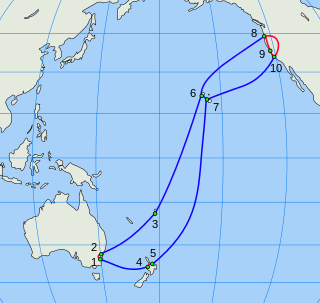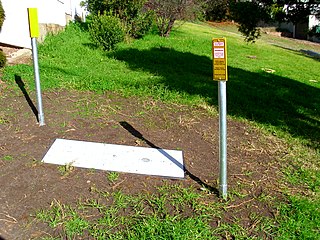Related Research Articles
Though Guam is a United States territory, some U.S. long-distance plans and courier services list Guam as an international location. As a result of Guam's being added to the North American Numbering Plan (NANP) in 1997, calls made to the U.S., Canada, or other participating countries from Guam only require the caller to dial a 1 followed by the area code.

Telecommunications in Australia refers to communication in Australia through electronic means, using devices such as telephone, television, radio or computer, and services such as the telephony and broadband networks. Telecommunications have always been important in Australia given the "tyranny of distance" with a dispersed population. Governments have driven telecommunication development and have a key role in its regulation.
PIPE Networks is an Australian telecommunications company, based in Brisbane, Queensland. It is a subsidiary of TPG Telecom. Its primary business is setting up peering exchanges. PIPE itself stands for "Public Internet Peering Exchange". The company also provides services such as co-location, telehousing, and fibre networks.

The Southern Cross Cable is a trans-Pacific network of telecommunications cables commissioned in 2000. The network is operated by the Bermuda-registered company Southern Cross Cables Limited. The network has 28,900 km (18,000 mi) of submarine and 1,600 km (990 mi) of terrestrial fiber optic cables, all which operate in a triple-ring configuration. Initially, each cable had a bandwidth capacity of 120 gigabit/s. Southern Cross offers capacity services from 100M/STM-1 to 100 Gbit/s OTU-4, including 1G, 10G and 40G Ethernet Private Line services.
SEA-ME-WE3 or South-East Asia - Middle East - Western Europe 3 is an optical submarine telecommunications cable linking those regions and is the longest in the world. Completed in late 2000, it is led by France Telecom and China Telecom, and is administered by Singtel, a telecommunications operator owned by the Government of Singapore. The Consortium is formed by 92 other investors from the telecom industry. It was commissioned in March 2000.

The Australia–Japan Cable, or AJC, is a 12,700 km submarine telecommunications cable system linking Australia and Japan via Guam that became operational in 2001. It had an original design capacity of 640 Gbit/s, but was initially equipped to use only 80 Gbit/s of this capacity. In April 2008 a capacity upgrade was completed, bringing equipped capacity to 240 Gbit/s. Design capacity was also increased to 1000 Gbit/s. Further upgrades will increase equipped capacity to meet increasing demand.
The APNG-2 submarine communications cable was constructed to link Papua New Guinea directly to Australia and indirectly to New Zealand and the rest of the world, and has been in service from late 2006.
TGN-Pacific is a submarine telecommunications cable system transiting the Pacific Ocean.
JASURAUS was a 5.332 Gbit/s, 2,800 km optical submarine telecommunications cable that connected Port Hedland, Australia, to Jakarta, Indonesia, with a further interconnection to the APCN and which was decommissioned in 2012.
The Telstra Endeavour is a submarine cable connecting Sydney and Hawaii. The cable went live in October 2008, with a capacity of 1.28 terabits per second in the future It was proposed on 28 March 2007 by Telstra, the largest telecommunications carrier in Australia.

Nextgen Networks is a wholly owned subsidiary of Vocus Group.
Internet in Australia first became available on a permanent basis to universities in Australia in May 1989, via AARNet. Pegasus Networks was Australia's first public Internet provider in June 1989. The first commercial dial-up Internet Service Provider (ISP) appeared in capital cities soon after, and by the mid-1990s almost the entire country had a range of choices of dial-up ISPs. Today, Internet access is available through a range of technologies, i.e. hybrid fibre coaxial cable, digital subscriber line (DSL), Integrated Services Digital Network (ISDN) and satellite Internet. In July 2009, the federal government, in partnership with the industrial sector, began rolling out a nationwide fibre-to-the-premises (FTTP) and improved fixed wireless and satellite access through the National Broadband Network. Subsequently, the roll out was downgraded to a Multi-Technology Mix on the promise of it being less expensive and with earlier completion. In October 2020, the federal government announced an upgrade by 2023 of NBN fibre-to-the-node (FTTN) services to FTTP for 2 million households, at a cost of A$3.5 billion.
PacRimWest was a twin-pair 560 Mbit/s optical submarine telecommunications cable which served as Australia's main link to the world along with its partner cables Tasman2 and PacRimEast.
Unity is a Trans-Pacific submarine communications cable between Japan and the United States that was completed in April 2010.
Europe India Gateway (EIG) is a submarine communications cable system that connects the U.K., Portugal, Gibraltar, Monaco, France, Libya, Egypt, Saudi Arabia, Djibouti, Oman, United Arab Emirates, and India.
West Indian Ocean Cable Company (WIOCC) operates as a wholesaler, providing capacity to international telecoms, cloud operators, content providers and internet service providers within and out of Africa. WIOCC offers carriers connectivity to over 550 locations across 30 African countries – utilising more than 75,000 km (47,000 mi) of terrestrial fibre and 200,000 km (120,000 mi) of submarine fibre-optic cable. WIOCC's international network reach currently extends to 100 cities in 29 countries in Europe and more than 700 cities in 70 countries globally.
The Australia Singapore Cable (ASC) is a 4,600 km fibre-optic submarine communications cable that entered service in September 2018, linking Australia and Singapore via Christmas Island and Indonesia. ASC is owned and operated by Vocus Communications and interconnects with the Vocus Australian domestic optical fibre network at the Australian landing site in Perth. The ASC consists of four fibre pairs and, at launch, had a total design capacity of 40 terabits per second.
Tasman Global Access (TGA) is a 2,288 km fibre-optic submarine communications cable that entered service in 2017, linking Australia and New Zealand. TGA consists of two fibre pairs and has a total design capacity of 20 terabits per second.
The Oman Australia Cable (OAC) is a 9,800 km fibre-optic submarine communications cable that entered service in September 2022, linking Oman and Australia via the Cocos (Keeling) Islands. The cable consists of three fibre pairs and had an initial design capacity of 39 terabits per second.
References
- ↑ "What is PPC-1?". Pipe International. 22 September 2009.
- ↑ More Bandwidth for Australia
- ↑ ISPs Get Slice of Guam Cable
- ↑ Welcome to the PPC-1 Blog
- ↑ Grubb, Ben (8 October 2009). "PPC-1 delivers more speed than expected". iTnews.
- ↑ "Pipe goes for 100 Gbps on PPC-1 subsea cable". iTnews. 7 September 2012.
- ↑ "What is happening with the Tyco Durable? (Part 2)". Pipe International. 24 June 2009.
- ↑ "Bevan's Speech at the Australian PPC-1 Landing". Pipe International. 30 May 2009.
- ↑ "Geography". Pipe International . Retrieved 25 June 2009.
- ↑ "NEWSFLASH: PPC-1 successfully transmits first light between Sydney and Guam! (blog)". Pipe International . Retrieved 24 August 2009.
- ↑ "Internode gives thumbs-up to PIPE's PPC-1 link". Internode Systems . Retrieved 22 September 2009.
- ↑ "Countdown to 8th October: What Happens Next? (blog)". Pipe International . Retrieved 24 August 2009.
- ↑ "Geography". Pipe International . Retrieved 25 June 2009.
- ↑ "Pipe Patches Up Financing For Submarine Cable". Archived from the original on 20 December 2008. Retrieved 19 December 2008.
- ↑ PPC-1 To Proceed As Scheduled
- ↑ Full Media Release: PPC-1 To Proceed As Scheduled